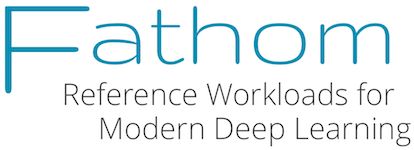Release: 1.0-rc0
This release reflects the state of Fathom more or less as it was for the paper published in September 2016. We are currently developing a somewhat more user-friendly version, which you can track in the GitHub issue tracker. If you're eager to use Fathom as it is, please let us know.
This paper contains a description of the workloads, performance characteristics, and the rationale behind the project:
R. Adolf, S. Rama, B. Reagen, G.Y. Wei, D. Brooks. "Fathom: Reference Workloads for Modern Deep Learning Methods." (Arxiv) (DOI)
| Name | Description |
|---|---|
| Seq2Seq | Direct language-to-language sentence translation. State-of-the-art accuracy with a simple, language-agnostic architecture. |
| MemNet | Facebook's memory-oriented neural system. One of two novel architectures which explore a topology beyond feed-forward lattices of neurons. |
| Speech | Baidu's speech recognition engine. Proved purely deep-learned networks can beat hand-tuned systems. |
| Autoenc | Variational autoencoder. An efficient, generative model for feature learning. |
| Residual | Image classifier from Microsoft Research Asia. Dramatically increased the practical depth of convolutional networks. ILSVRC 2015 winner. |
| VGG | Image classifier demonstrating the power of small convolutional filters. ILSVRC 2014 winner. |
| AlexNet | Image classifier. Watershed for deep learning by beating hand-tuned image systems at ILSVRC 2012. |
| DeepQ | Atari-playing neural network from DeepMind. Achieves superhuman performance on majority of Atari2600 games, without any preconceptions. |
Read the Fathom Quickstart Guide and let us know if you have any questions.
Submit a GitHub issue if you have a suggestion or find a bug.

